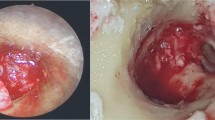Abstract
Both type of CSOM, tubotympanic which is considered safe as well as atticoantral which is considered unsafe may lead to erosion of the ossicular chain. Discontinuity of the ossicular chain is typically confirmed only during an operation. Knowing before surgery whether the patient has an ossicular discontinuity is important because it allows the surgeon to know the possibility of performing an ossiculoplasty and obtaining patient consent. The aims is to (1) study the incidence of incus necrosis in safe and unsafe CSOM. (2) Determine the preoperative predictive factors for incus necrosis. (3) Use angled otoscopes to determine the incidence of residual disease peroperative after conventional microscopic surgery. This is a prospective study carried out in the department of otorhinolaryngology, Govt Doon medical college, Dehradun from July 2014 to July 2016. A total of 100 patients who presented with CSOM and have not undergone any surgical procedure for the same were included in this study. Patients group was divided into cholesteatoma and non cholesteatoma group. Both groups were subdivided into intact and eroded incus group and were analysed in 11 parameters which were compared statistically. Incudal necrosis is more common in cholesteatoma group. In non cholesteatoma ears subtotal perforation with exposure of IS joint is reliable indicators of incudal necrosis. In non cholesteatoma group extension of cholesteatoma to tympanic sinus and mastoid and presence of persistent discharge are reliable indicators of necrosed incus. Moderate to moderately severe hearing loss indicate incudal necrosis in both groups therefore we conclude that these parameters can be reliably considered as predictors for incudal necrosis preoperatively.
Similar content being viewed by others
References
Srinivas C, Kulkarni NH, Bhardwaj NS, Kottaram PJ, Kumar SH, Mahesh V (2014) Factors influencing ossicular status in mucosal chronic otitis media—an observational study. Indian J Otol 20:16–19
Deka RC (1998) Newer concepts of pathogenesis of middle ear cholesteatoma. Indian J Otol 4(2):55–57
Kairo AK, Sikka K, Kumar R, Kudawla K (2014) An oblivious cholesteatoma. Indian J Otol 20:92–93
Tos M (1979) Pathology of the ossicular chain in various chronic middle ear diseases. J Laryngol Otol 93:769–780
Kerr AG (1994) Scott-Brown’s oto-rhino-laryngology and head and neck surgery, 7th edn. WB Saunders, Philadelphia
Mohanty S, Gopinath M, Subramanian M, Sudhir A (1998) Relevance of pure tone average (PTA) as a predictor for incus erosion middle ear cholesteatoma. Indian J Otol 4(2):55–57
Kärjä J, Jokinen K, Seppälä A (1976) Destruction of ossicles in chronic otitis media. J Laryngol Otol 90(6):509–518
Thomsen I, Bretleu P, Jorgensen MB (1981) Bone resorption in chronic otitis media: the role of cholesteatoma, a must or an adjunct. Clin Otolaryngol 6:179
Ebenezer J, Rupa V (2010) Preoperative predictors of incudal necrosis in chronic suppurative otitis media. Otolaryngol Head Neck Surg 142(3):415–420
Jeng FC, Tsai MH, Brown CJ (2003) Relationship of preoperative findings and ossicular discontinuity in chronic otitis media. Otol Neurotol 24(1):29–32
Author information
Authors and Affiliations
Corresponding author
Ethics declarations
Conflict of interest
All the contributing authors have read the article and declare that there is no conflict of interests.
Human and Animal Rights
This article does not include any studies with animals performed by any of the authors.
Informed Consent
Informed consent was obtained from all individual participants included in the study.
Rights and permissions
About this article
Cite this article
Tripathi, P., Nautiyal, S. Incidence and Preoperative Predictive Indicators of Incudal Necrosis in CSOM: A Prospective Study in a Tertiary Care Centre. Indian J Otolaryngol Head Neck Surg 69, 459–463 (2017). https://doi.org/10.1007/s12070-017-1224-0
Received:
Accepted:
Published:
Issue Date:
DOI: https://doi.org/10.1007/s12070-017-1224-0



